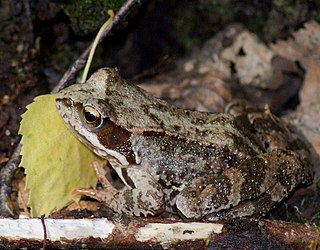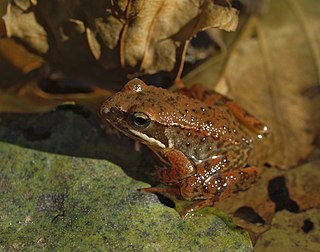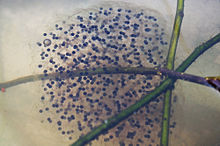
Lithobates pipiens formerly Rana pipiens, commonly known as the northern leopard frog, is a species of leopard frog from the true frog family, native to parts of Canada and the United States. It is the state amphibian of Minnesota and Vermont.

The common frog or grass frog, also known as the European common frog, European common brown frog, European grass frog, European Holarctic true frog, European pond frog or European brown frog, is a semi-aquatic amphibian of the family Ranidae, found throughout much of Europe as far north as Scandinavia and as far east as the Urals, except for most of the Iberian Peninsula, southern Italy, and the southern Balkans. The farthest west it can be found is Ireland. It is also found in Asia, and eastward to Japan. The nominative, and most common, subspecies Rana temporaria temporaria is a largely terrestrial frog native to Europe. It is distributed throughout northern Europe and can be found in Ireland, the Isle of Lewis and as far east as Japan.

Rana is a genus of frogs commonly known as the Holarctic true frogs, pond frogs or brown frogs. Members of this genus are found through much of Eurasia and western North America. Many other genera were formerly included here. These true frogs are usually largish species characterized by their slim waists and wrinkled skin; many have thin ridges running along their backs, but they generally lack "warts" as in typical toads. They are excellent jumpers due to their long, slender legs. The typical webbing found on their hind feet allows for easy movement through water. Coloration is mostly greens and browns above, with darker and yellowish spots.

The pickerel frog is a small North American frog, characterized by the appearance of seemingly "hand-drawn" squares on its dorsal surface.

The moor frog is a slim, reddish-brown, semiaquatic amphibian native to Europe and Asia. Moor frogs are known for their ability to freeze solid and survive thawing. The frog makes use of various cryoprotectants i.e. antifreeze that decrease its internal freezing temperature. The species is distributed over a large range, covering a significant portion of Eurasia. Male moor frogs are known to turn blue temporarily during the height of mating season. This coloration is assumed to signal a mate's fitness. Moor frogs typically mate through multimale amplexus a form of polyandry.

The Italian agile frog, also known as Lataste's frog, is a species of frog in the family Ranidae. The species is native to southern Europe, primarily found in the Po River Basin of Italy. It is one of the most endangered amphibian species in Europe, with its populations declining sharply in recent years, and has been the focus of multiple conservation plans.

The Iberian frog, also known as Iberian stream frog, is a species of frog in the family Ranidae found in Portugal and Spain. Its natural habitats are rivers, mountain streams and swamps. It is threatened by habitat loss, introduced species, climate change, water contamination, and increased ultraviolet radiation.

The Pyrenean frog or Pyrenees frog is a species of frogs in the family Ranidae found in the Pyrenees mountains of France and Spain. Its natural habitats are fast-moving mountain streams and their surroundings. The IUCN lists it as "endangered".

Morgetshofsee is a kettle lake at Thayngen in the canton of Schaffhausen, Switzerland. The lake and its surroundings are listed in the Federal Inventory of Amphibian Spawning Areas as a site of national importance.
Rhabdias bufonis is a species of parasitic nematode in the family Rhabdiasidae. It was first described from the lungs of the European common toad (Bufo bufo) but has also been found in a number of other species of frog.
Haplometra cylindracea is a trematode parasite of frogs. Adult worms measure usually 10 mm and they are located in the lungs. H. cylindracea develops through 2 intermediate hosts: the first, a freshwater snail, the second, a water beetle.

”Muhalnitsa” is a protected area in western Bulgaria, located at one kilometre south of the town of Botevgrad and at 63 km north-east of the capital Sofia. It is situated in the Botevgrad valley in the western section of the Balkan Mountains. ”Muhalnitsa” was established in 1992 to protect a unique breeding migration of the common frog.

Celtic Reptile & Amphibian, also known as Celtic Rewilding Ltd, is a conservation company, established in 2020, by Harvey Tweats and Tom Whitehurst, with the initial aim of reintroducing extinct reptiles and amphibians back to rewilding projects within the UK. However, the company's scope has since broadened. It is based in Leek, Staffordshire.














